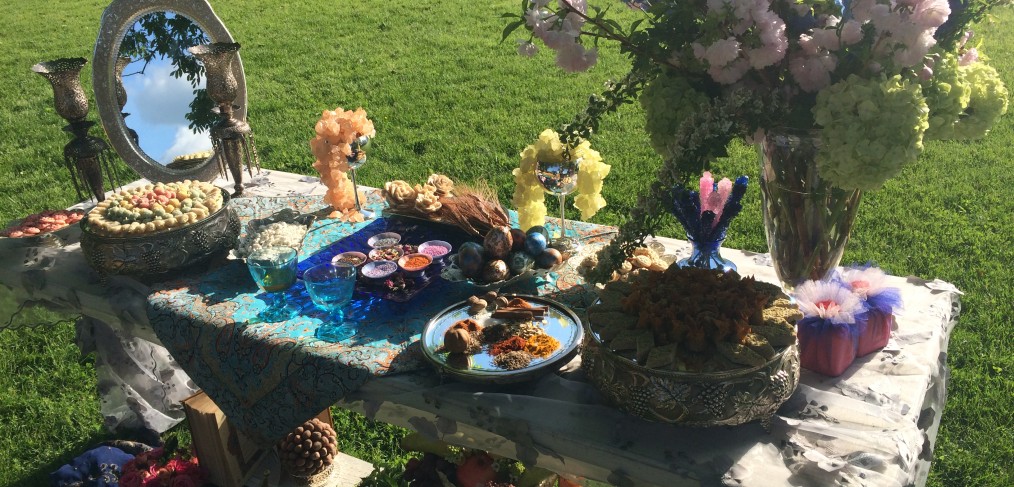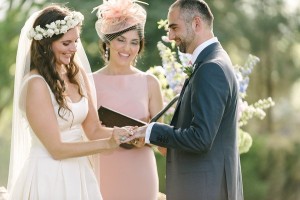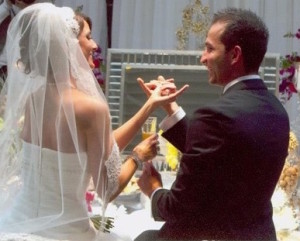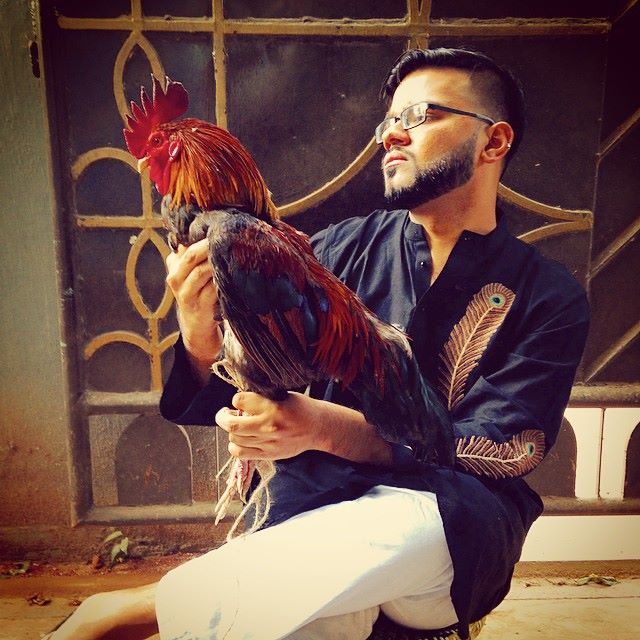
I Do: Marrying Food with Traditions Worldwide
In an increasingly globalized world, more and more weddings have become multicultural affairs. Guests from multiple continents eat food from varying cuisines, all at the same reception. Whether ceremonies indulge in extravagance or find solace in simplicity, Nilou Nouri ensures cultural traditions are preserved to grant newlyweds the happily-ever-afters of their dreams.

Nilou (center) at work.
Nilou is not your typical wedding minister. For one, she is always fabulously dressed, oftentimes complementing the bride and the groom. More surprisingly, she is also a cultural emissary in disguise – weddings just happen to be her preferred office of operations.
After years of working in the non-profit sector, Nilou’s venture into the world of weddings was nothing short of an adventure. At first, it was cousins and close friends who asked her to help with their ceremonies. Then, it was a friend of a friend or a guest at a reception. Now, she finds herself hosting beautiful weddings across the globe.
Nilou employs all parts of her multi-faceted skill set – from her academic background in anthropology to her experiences as an events manager – to host seamless and elegant ceremonies. Nilou’s is an intimate approach. Several months in advance of the big day, she meets with the couple to discuss the components of the ceremony and vows. She emphasizes the importance of designing vows that truly reflect the couple, not just as individuals, but also as members of their respective communities. She applies ancient Zoroastrian rituals with modern social memes to truly gauge the happy couple. Her liaise with the wedding planners, musicians, and others involved with the wedding ensure a cohesive theme to the wedding.
Nilou’s greatest strength lies in her understanding of wedding cultures. She reflects upon how weddings are steeped in traditions. Symbols of unity, fidelity, and fertility abound in the many wedding traditions of the world. No degree of modernity can stamp away the significance of the union of two individual souls, and longstanding spiritual traditions persist even in the most ostensibly secular weddings. Moreover, weddings also act as “repositories” of ancient traditions that may otherwise disappear in other aspects of life.

The Asal (Honey) Ceremony
For example, she explained how during Persian weddings, a common feature is the sofreye aghd, a display of ancient Persian and Zoroastrian symbols, mostly concerning the natural and spiritual realms, as well as items of personal importance for the couple. Though nonfood items are also displayed, like a revered book or a mirror, most of the things on the sofreye aghd are culinary. The Seven Herbs, including poppy and nigella seeds, share the table with many sweet pastries. Honey, which has strong spiritual and mythological aspects in most world cultures, features prominently at Persian weddings, as the bride and the groom dip their pinkies (right hand only!) to feed each other in front of their families. In some parts of Iran, particularly in Shiraz, the honey is coupled with yogurt. An omnipresent ingredient in Iranian cuisines, yogurt symbolizes a “bright, white destiny”, or sefid bakhthi.
Of course, such traditions are not just limited to Persian weddings. Couples celebrate their momentous day with interesting, and oftentimes, ‘sweet’ traditions the world over. In France, the bride and groom feed each other pieces of creampuffs from the towering croquembouche. All over South Asia, where marriages are more of a community affair than individual endeavors, hundreds if not thousands of sweets and pastries of a wide variety are shared amongst the families of the couple. The desire is to “sweeten the mouth” (moo mithai or mishti mukh) of the unifying clans.
However, wedding traditions don’t always necessarily have to be so deeply entrenched in the millennia gone by. Nilou encourages her clients to be originators of traditions themselves, particularly for couples that come from different cultural backgrounds or couples that enjoy attributes of non-native cultures. Nilou recollects how one African-American couple used different spices and foods to symbolize the different, albeit complementing, aspects of their relationship. Cayenne pepper represented the initial spark, vinegar showed the patience, and bittersweet chocolate-covered almonds symbolized the ups and downs of their life together.
Food and its significance are of course not just the purview of the bride and the groom. As fellow foodies will surely agree, weddings are a great excuse to attend a sumptuous feast, all the while partying with friends and family. Until recently, in most cultures around the world, wedding ceremonies were considered a social event intended for the celebration of the couple’s entry into the community. It was a way of validating a relationship in front of not just peers and family members, but also such social intuitions as state and religion. Of course, the best way to connect all of these disparate pieces was, and still is, a lavish feast.
A shared aspect of wedding food is that it reflects the best and finest of the community’s culinary traditions. Weddings were, and still are, the central point of many people’s lives, and to celebrate such a momentous occasion, wedding foods are usually of the highest caliber. Whether it is lobsters or filet mignons in New York or the spice-infused tagines of Marrakesh, the guests are treated like royalty. Traditional Chinese wedding banquets consist of several courses, each meant to signify a positive aspect of conjugal life. With its reddish color – red being the universal Chinese color of happiness – the Peking duck often features at Chinese wedding dinners, with the hope of the newlyweds coupling for life like the delicious waterfowls.
Javaher polow, or jeweled rice pilaf, is a staple at most Persian weddings. Nilou explains how, even if a couple is thoroughly “westernized” or maintains very distant relations with Persian culture, this colorful arrangement of rice, fruits, and nuts of javaher polow can still often be observed at the banquet. The dish encompasses many ubiquitous and symbolic ingredients in Persian cuisine, like rice and pistachios, which carry cultural significance beyond just the nuptial night.
Wedding ceremonies border on the sacred and celebratory. Not only is a wedding momentous for the couple tying the knot, it is also a time for peers and family to welcome new members into their respective communities. And at the center of it all is the food, unifying the sacred with the revelers, and the couple’s future with traditions from the past. Some say the window to a beloved’s soul is through the eyes. Little do they know, it has always been through the palate.
To get in touch with Nilou, please visit: www.weddingvowsbynilou.com
About the Author
Abdul-Kadar (AK) Rahim is a marketer and product developer with a healthy obsession with all-things culinary. He is part of NooshTube’s creative team, collaborating on content and marketing. Though brought up on the East Coast, he has a tendency to roam around the world, collecting stories and recipes along the way.

